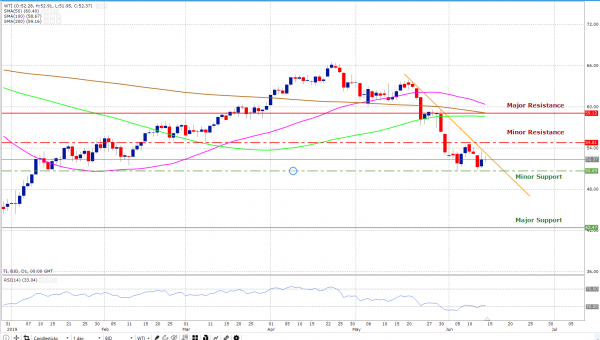Crude and Brent oil are up nearly 10.93% and 12.50% year-to-date respectively. These percentage gains have a special meaning when we look at things from the lens of slowing global economic growth. Over the past two days, speculators tried their best to push the prices higher on the back of the news that two oil tankers were attacked in the Gulf of Oman, precisely on Thursday. Looking at the history, such an event could easily push the prices higher by 5-7%, however, this particular incident failed to bring similar kind of moves in the oil prices. We did see the crude prices jumping higher by 2% due to this event but these gains were merely covering the weekly losses.
External Forces Should Not Promote War In The Middle East
The reason is pretty simple for oil prices not exploding like the 1991 when U.S. forces created a major turmoil between Kuwait and Iraq by launching the operation called “Desert Storm”. Simply put, we still have mammoth amount of oil supply and this is keeping the lid on the oil prices. Looking at the recent EIA data, it shows that crude inventories are still rising, the number jumped by 15.7 million barrels marking the largest monthly increase going back all the way to 1991 for the month of May.
This is not to say that the ongoing conflicts cannot errupt anymore.
External forces should not be getting engaged in the Middle Eastern affairs. This is because it will only make matters worse. The U.S. is clearly blaming Iran for these recent attacks on oil tankers while Iran is rejecting search accusing statements. The Middle East is a very sensitive part of the world, we have Iran and Saudi Arabia, both locked up in unconstructive dialogues for decades. External comments and involvements make things only worse in the region. Remember in the 1980s, the U.S. shot down a civilian Iranian aircraft killing 300 passengers after mistaking it for a fighter plane. The efforts should be to promote and create peace rather than making allegations and targeting one particular country.
The Two Important Factors
More importantly, the U.S. needs to resolve it’s own matters first rather than taking sides with other countries in different parts of the world. The ongoing trade war between the U.S. and China is the biggest issue which is damping the oil demand. The two major reasons that we did not see the surge in the oil price are:
- The mammoth increase in the U.S. shale oil production due to the higher oil prices
- The never ending trade war between the U.S. and China
According to the EIA oil data, the U.S. shale oil production has increased to such a level that the country only needed to buy 1,000,000 barrels of oil per day from the countries based in the Persian Gulf during the month of March. Back in 2003, this number used to stand at 3,000,000 barrels a day.
A Technical View
From a technical analysis perspective the price of crude oil is down nearly 22% from its high off $66.37 formed back in April 2019. The daily chart shows that the Relative Strength Index is still trading in an oversold territory which means it is likely for the prices to move higher. However, any upward move may be capped by the resistance of $54.81. A break of this level will open the room towards the next resistance of $59.12, this is where the 100-day moving average sits.












